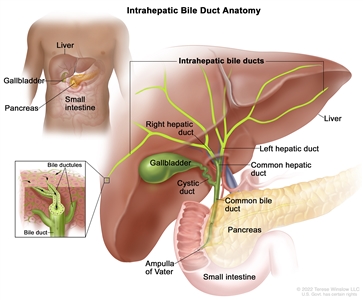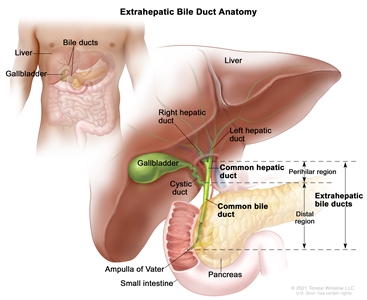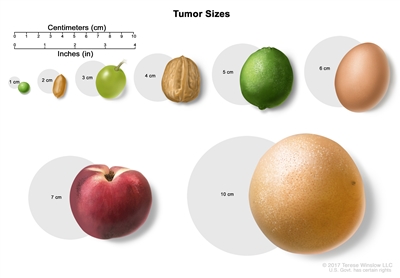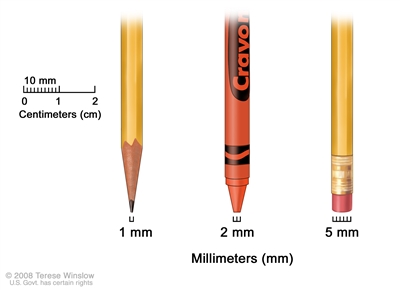Bile Duct Cancer Treatment
This page describes the different types of treatment for bile duct cancer (cholangiocarcinoma). Which of these treatments a person receives will depend on whether the cancer can be completely removed with surgery (resectable) or not (unresectable). To learn more, see treatment of resectable and treatment of unresectable bile duct cancer.
Types of treatment
Surgery
The following types of surgery are used to treat bile duct cancer:
- Removal of the bile duct: This surgical procedure is done to remove part of the bile duct if the tumor is small and is in the bile duct only. Lymph nodes are removed and tissue from the lymph nodes is viewed under a microscope to see if there is cancer.
- Partial hepatectomy: This is a surgical procedure to remove the part of the liver where cancer is found. The part removed may be a wedge of tissue, an entire lobe, or a larger part of the liver, along with some normal tissue around it.
- Whipple procedure: During this surgical procedure the head of the pancreas, the gallbladder, part of the stomach, part of the small intestine, and the bile duct are removed. Enough of the pancreas is left to make digestive juices and insulin.
After the doctor removes all the cancer that can be seen at the time of the surgery, some people may receive chemotherapy or radiation therapy to kill any cancer cells that are left. Treatment given after surgery to lower the risk that the cancer will come back is called adjuvant therapy. It is not yet known whether chemotherapy or radiation therapy given after surgery helps keep the cancer from coming back.
The following types of palliative surgery may be done to relieve symptoms caused by a blocked bile duct and improve quality of life:
- Biliary bypass: If cancer is blocking the bile duct and bile is building up in the gallbladder, a biliary bypass may be done. During this operation, the doctor will cut the gallbladder or bile duct in the area before the blockage and sew it to the part of the bile duct that is past the blockage or to the small intestine. This type of surgery creates a new pathway around the blocked area.
- Endoscopic stent placement: If the tumor is blocking the bile duct, surgery may be done to put in a stent (a thin, flexible tube) to drain bile that has built up in the area. The doctor may place the stent through a catheter that drains the bile into a bag on the outside of the body or the stent may go around the blocked area and drain the bile into the small intestine.
- Percutaneous transhepatic biliary drainage: This procedure is used to x-ray the liver and bile ducts. A thin needle is inserted through the skin below the ribs and into the liver. Dye is injected into the liver or bile ducts and an x-ray is taken. If the bile duct is blocked, a stent may be left in the liver to drain bile into the small intestine or a collection bag outside the body.
Radiation therapy
Radiation therapy uses high-energy x-rays or other types of radiation to kill cancer cells or keep them from growing. These are the main ways radiation might be given to treat bile duct cancer:
- External radiation therapy: A machine outside the body sends radiation toward the area of the body with cancer. Radiation is given in a series of treatments to allow healthy cells to recover and to make radiation more effective. The number of treatments is based on details about the cancer, such as the size and location of the tumor.
It is not known whether external radiation therapy helps in the treatment of resectable bile duct cancer. In unresectable, metastatic, or recurrent bile duct cancer, new ways to improve the effect of external radiation therapy on cancer cells are being studied:
- Hyperthermia therapy: Body tissue is exposed to high temperatures to make cancer cells more sensitive to the effects of radiation therapy and certain anticancer drugs.
- Radiosensitizers: Drugs called radiosensitizers make cancer cells more sensitive to radiation therapy. Combining radiation therapy with radiosensitizers may kill more cancer cells.
- Internal radiation therapy: A radioactive substance is sealed in needles, seeds, wires, or catheters that are placed directly into or near the bile duct.
External and internal radiation therapy are used to treat bile duct cancer and may also be used as palliative therapy to relieve symptoms and improve quality of life.
Learn more about Radiation Therapy to Treat Cancer and Radiation Therapy Side Effects.
Chemotherapy
Chemotherapy uses drugs to stop the growth of cancer cells, either by killing the cells or by stopping them from dividing. There are two main types of chemotherapy used to treat bile duct cancer.
- Systemic chemotherapy: When chemotherapy is taken by mouth or injected into a vein or muscle, the drugs enter the bloodstream and can reach cancer cells throughout the body.
Systemic chemotherapy is used to treat unresectable, metastatic, or recurrent bile duct cancer. The following chemotherapy drugs may be used:
- gemcitabine and cisplatin
- capecitabine and oxaliplatin (XELOX)
- gemcitabine and oxaliplatin (GEMOX)
- gemcitabine and capecitabine
- Regional chemotherapy: When chemotherapy is placed directly into an organ, or a body cavity such as the abdomen, the drugs mainly affect cancer cells in those areas.
Intra-arterial embolization is being studied in the treatment of unresectable, metastatic, or recurrent bile duct cancer. It is a procedure in which the blood supply to a tumor is blocked after anticancer drugs are given in blood vessels near the tumor. Sometimes, the anticancer drugs are attached to small beads that are injected into an artery that feeds the tumor. The beads block blood flow to the tumor as they release the drug. This allows a higher amount of drug to reach the tumor for a longer period of time, which may kill more cancer cells.
It is not known whether systemic chemotherapy helps in the treatment of resectable bile duct cancer.
To learn about the different ways chemotherapy works against cancer, what to expect when receiving chemotherapy, and how to manage chemotherapy side effects, see Chemotherapy to Treat Cancer.
Liver transplant
In a liver transplant, the entire liver is removed and replaced with a healthy donated liver. A liver transplant may be done in people with perihilar bile duct cancer. If the person has to wait for a donated liver, other treatment is given as needed.
Targeted therapy
Targeted therapy is a type of treatment that uses drugs or other substances to identify and attack specific cancer cells. Your doctor may suggest biomarker tests to help predict your response to certain targeted therapy drugs. Learn more about Biomarker Testing for Cancer Treatment.
The following targeted therapy drugs may be used to treat bile duct cancer:
Learn more about Targeted Therapy to Treat Cancer.
Immunotherapy
Immunotherapy helps a person's immune system fight cancer.
The following immunotherapy drugs may be used to treat bile duct cancer:
Learn more about Immunotherapy to Treat Cancer and Immunotherapy Side Effects.
Clinical trials
A treatment clinical trial is a research study meant to help improve current treatments or obtain information on new treatments for patients with cancer. For some patients, taking part in a clinical trial may be an option.
Use our clinical trial search to find NCI-supported cancer clinical trials that are accepting patients. You can search for trials based on the type of cancer, the age of the patient, and where the trials are being done. Clinical trials supported by other organizations can be found on the ClinicalTrials.gov website.
To learn more about clinical trials, see Clinical Trials Information for Patients and Caregivers.
Treatment of resectable (localized) bile duct cancer
If the cancer has not spread and is in a place where surgery can be safely done, the tumor and some of the tissue around it will be removed. This lowers the chance of the cancer coming back. Chemotherapy with or without radiation therapy may be given after surgery.
Treatment of resectable intrahepatic bile duct cancer may include surgery to remove the cancer. A partial hepatectomy with or without embolization may be done before the surgery.
Treatment of resectable perihilar bile duct cancer may include:
- surgery to remove the cancer, which may include partial hepatectomy
- stent placement or percutaneous transhepatic biliary drainage, as palliative therapy to relieve jaundice and other symptoms and improve quality of life
Treatment of resectable distal bile duct cancer may include:
- surgery to remove the cancer, which may include a Whipple procedure
- stent placement or percutaneous transhepatic biliary drainage, as palliative therapy to relieve jaundice and other symptoms and improve quality of life
Adjuvant therapy for resectable bile duct cancer may include:
- chemotherapy
- external-beam radiation therapy
- a clinical trial of adjuvant therapy
Treatment of unresectable bile duct cancer (including metastatic or recurrent disease)
Most people with bile duct cancer cannot have their cancer completely removed with surgery. This may be the case if the cancer has spread too far, the cancer is in a place that is too difficult to completely remove with surgery, or the patient is not healthy enough for surgery.
Treatment of unresectable bile duct cancer (including metastatic or recurrent disease) may include:
- stent placement or biliary bypass, as palliative treatment to relieve symptoms and improve quality of life
- external or internal radiation therapy, as palliative treatment to relieve symptoms and improve quality of life
- systemic chemotherapy
- immunotherapy (durvalumab or pembrolizumab) and systemic chemotherapy
- targeted therapy with pemigatinib
- a clinical trial of various combinations of chemotherapy
- a clinical trial of immunotherapy or targeted therapy in people with mutations (changes) in certain genes
Last Revised: 2024-05-24
If you want to know more about cancer and how it is treated, or if you wish to know about clinical trials for your type of cancer, you can call the NCI's Cancer Information Service at 1-800-422-6237, toll free. A trained information specialist can talk with you and answer your questions.



